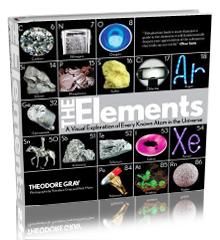Native copper nugget. (External Sample)
Copper, like gold, occurs fairly pure in nature, in lumps. Reader Jim O'Brien writes:As a woodworker and a resident of Michigan's "Copper Country", I find your Wooden Periodic Table most intriguing. Thanks for all your work in developing and posting the website.
Just to add another data point, the native copper specimens you show from the Harvard Natural History Museum almost certainly originated from the Lake Superior copper region and likely from the Calumet & Hecla mines on the Keweenaw Peninsula. They look familiar to me. I see kids selling them on the roadside to tourists all summer long.
Boston money financed the mines up here (Shaw, Quincy, Adams Paine, etc.). Alexander Agassiz, an avid collector and son of Louis (founder of the Museum), was curator there for many years and was appointed President of C&H just after the Civil War (http://www.famousamericans.net/alexanderagassiz/). Mining captains would compete for the best specimens, rewarding miners who could deliver the most spectacular examples from the deeps. Some mines up here go down over 9,000 ft.
Location: The Harvard Museum of Natural History
Photographed: 2 October, 2002
Size: 18
Purity: >90%
|

